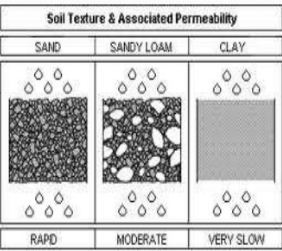7th Grade > Chemistry
SOIL MCQs
:
Each factor: 0.5 Mark
The nature of soil depends on the following factors:
1.The parent material from which the soil has disintegrated.
2.The climatic condition that induced the agents of weathering for the soil to form.
3.The relief features of the land, that is, the topography that exists there.
4. The flora, fauna, and microorganisms at play that contributed to the rate of humus formation.
:
Name of the soil: 1 Mark
Reasons: 2 Marks
Loamy soil is best for growing plants.
It is so because loamy soil has all the three particles like sand, clay, and silt in perfect balance with each other. The other features of loamy soil are:
1. They hold moisture to keep plant roots moist.
2. They drain well enough to prevent roots from becoming waterlogged.
3. They have a rich content of humus to ensure adequate nutrient supply for the plants.
:
Each part: 1 Mark
i. A vertical section through different layers of the soil is called soil profile.
ii. Weathering is the process by which soil is formed.
iii. Water drains quickest through sandy soil.
:
Definition: 2 Marks
Formula: 1 Mark
Solution: 2 Marks
Water absorption rate of the soil is defined as the capacity of the soil to absorb water from the surrounding areas in a specific amount of time. It is also called the water retention capacity of soil.
Now the details of the soil sample is:
Amount of water = 360 mL
Time taken for this amount to percolate down the sample= 60 minutes
hence
Rate of percolation = Amount of water (mL)Percolation time (min) = 360 mL60 m =6 mL/min
Ans: 6 mL/min
:
Each point: 1 Mark
(i) If particles are larger in size and cannot fit close together and have space between them, then it is sandy soil.
(ii) We know that clay can be differentiated by looking at the size of particles because they would be less than 0.075 mm in size. When water is added to a sample of soil and it turns into a sticky mass and shows great variation in volume and shows considerable strength when dried, then the soil must be clay.
(iii) If the soil sample has particulate matter larger than the previous sample and exhibits slightly plastic or a non-plastic behaviour, then the soil must be silt.
(iv) If the soil sample has even proportions of sand, silt and clay, it has to be loamy soil.
(v) If the soil is dark in colour and has dead and decaying matter, it must be humus.
:
Each part: 1 Mark
With a sloping ground, the chance of soil runoffs including water runoffs is high.
Loamy soil is best suited for growing lentils. This is because loamy soil has about 40% sand, 40% silt and 20% clay by weight. The soil's texture, especially its ability to retain nutrients and water are crucial inputs to agriculture.
:
Reasons: 1 Mark each
Clayey soil is useful for growing crops because of the following reasons:
(i) It has very good water retaining capacity.
(ii) This soil is rich in humus and is very fertile.
(iii) It contains useful organic minerals.
:
Explanation: 1 Mark each including figure
The different layers of soil are:
1) A-Horizon: This is the uppermost layer of the soil and is called as topsoil. The colour of this layer is the darkest since it is rich in humus and minerals. It is soft, porous and holds more water than the other layers. Plants get most of the nutrients and water from this layer.
2) B-Horizon: It is the second most layer from the top, lighter in color, may contain little humus and is rich in minerals. It serves as a water reservoir.
3) C-Horizon: It consists of small pieces of original rock broken due to weathering.
4) Bedrock: It is the bottom layer of the soil and is unweathered solid rock.![Click to Enlarge Image Explain The Different Layers Of Soil. [5 MARKS]](https://lakshyaeducation.in/quizpics/quiz/content_pro.jpg)
:
A
Soil is a vital natural resource. It supports the growth of plants and crops by giving nutrients. Agriculture fulfills the food requirement for the survival of human beings. It provides shelter to organisms such as earthworms and many micro-organisms.

















